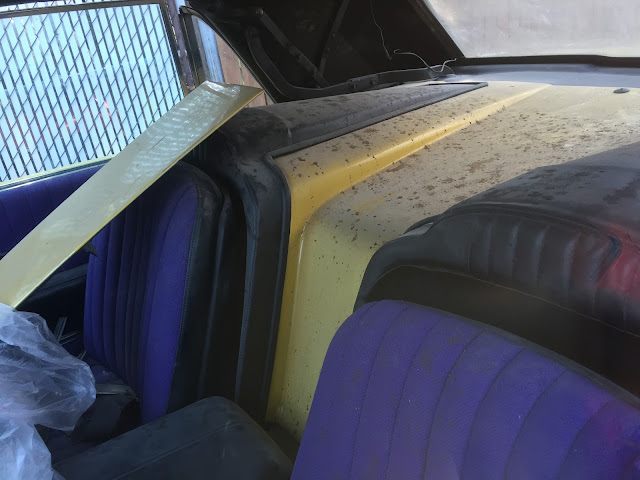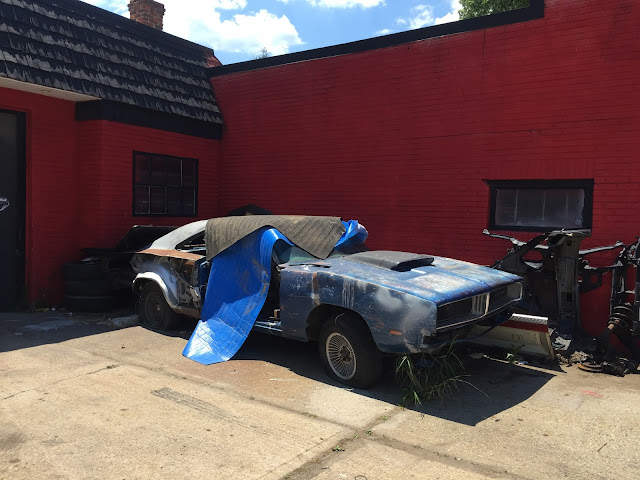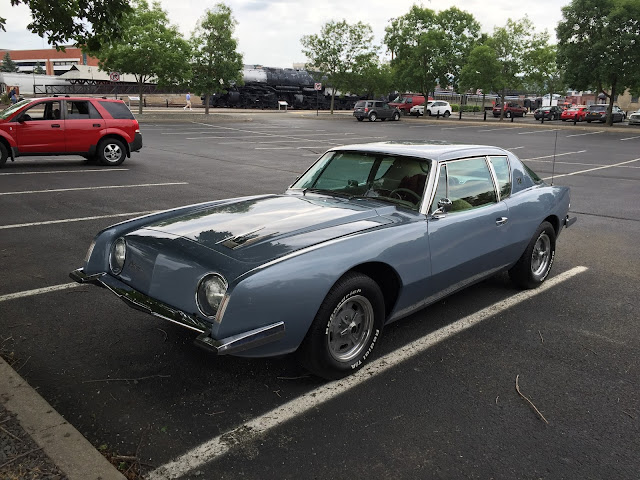JERSEY RIDICULOUSNESS!
I was on a rambling drive to the Delaware Water Gap when I decided to roll through some local New Jersey streets to see if there were any cool industrial ruins or cars. I found plenty of both but this freaky vision takes the cake!
What? Why? Who?
Look I don't have the answers. NOBODY has the answers. I think this might be an answer to an unspoken question by a madman. Regardless, what we have here is a 1965 Ford Thunderbird convertible in some ungodly horrific aftermarket LOOK AT ME yellow. Whatever with the color let's get to the glaring fact that this thing is bizarrely customized to the point where there are no headlights. Dude! You got rid of the headlights? If you're going this bonkers why start with such a nice and somewhat rare car? Are you absolutely certain you only want to cruise in the daytime?
Look I don't have the answers. NOBODY has the answers. I think this might be an answer to an unspoken question by a madman. Regardless, what we have here is a 1965 Ford Thunderbird convertible in some ungodly horrific aftermarket LOOK AT ME yellow. Whatever with the color let's get to the glaring fact that this thing is bizarrely customized to the point where there are no headlights. Dude! You got rid of the headlights? If you're going this bonkers why start with such a nice and somewhat rare car? Are you absolutely certain you only want to cruise in the daytime?
Alright perhaps there are lights behind that grill but still, what a strange decision. I love cars with their headlights behind power flip-up doors but this seems unnecessary. Maybe it's a fiberglass front to save weight but then why choose a convertible with its heavier reinforced frame? I'll lay off now.
I'm fairly certain the bumper is the original under that paint. The main identifying feature of the '65 is still on display here; that small faux vent indentation behind the front fender well is a 1 year only detail for this generation 'bird.
This just added to my frustration! It seems this particular 'bird is fitted with the rare roadster option. The backseat exists in this car, it's just hidden beneath this large removable cover from the factory. These are referred to as the Batman Roadster covers as they make the car look faintly like the '60s Barris Custom Batmobile when the top is down. This is a scarce and sought-after piece for sure.
This is obviously going through a revamping so it can continue to bring tears of shock to people for years to come. While the exhaust tips are poking out from underneath the rear bumper you can see the yellow protrusion just behind the lower edge of the front wheel suggesting that this might've had lake pipes at one point.
Let's turn our attention to that magenta schnoz poking out in front of this blindbird.
Let's turn our attention to that magenta schnoz poking out in front of this blindbird.
What we have here is a 1971 Chevrolet Chevelle SS all tarted up in some sort of trashy magenta. Really subtle with the high-rise hood scoop and fat tires in the back but you know what? On a Chevelle it makes total sense!
Both the '71 and '72 Chevelle had identical bodies and a single headlight on each side as opposed to quads, but the '71 only had a single horizontal grill bar while the '72 had 2.
Both the '71 and '72 Chevelle had identical bodies and a single headlight on each side as opposed to quads, but the '71 only had a single horizontal grill bar while the '72 had 2.
This car should be all set up for the dragstrip. Heck I know a guy who races a '71 Chevelle on the quarter mile all season every summer. This one is sporting a vinyl roof which, while light as can be and not too much of a drag on aerodynamics, is superfluous when it comes to racing. Who knows how this started out. Maybe it has air conditioning too.
But wait a minute! There in the background lies one of the ultimate muscle car icons; a 1969 Dodge Charger. This is the same year, make, and model as the General Lee from the Dukes of Hazzard!
This example looks like it's wearing remnants of the original color Bright Blue Poly. That massive hood scoop is aftermarket but these could be ordered ready for the dragstrip from the factory in '69. The large enough 383 V8 was standard, but you could specify a huge 440 Magnum or the legendary 426 Hemi as well. Incidentally the way to differentiate the '69 from the '68 from the front is that the '69 had this center divider to the grill. There was a Nascar-inspired version called the Charger 500 that had exposed headlights which saved weight and very slightly helped with aerodynamics. Of course there was also the Charger Daytona which came with the pointed metal nose and massive rear wing (among other drag-killing aerodynamics) but that was so wild that it's hard to think of it as the same overall model.
This beast is in pieces with the entire quarter cut out and doors removed.
This goes to show the value and increasing scarcity of this car. Even if you have a frame and a vin tag it's probably worth the time and effort to try and create a car out of it. The Dukes of Hazzard went through somewhere between 255 and 320 1969 Chargers jumping and totaling them constantly. That and the fact that they were built to drive mercilessly used them up before they became valuable again.
Hats off to New Jersey for not disappointing!
Hats off to New Jersey for not disappointing!





















































